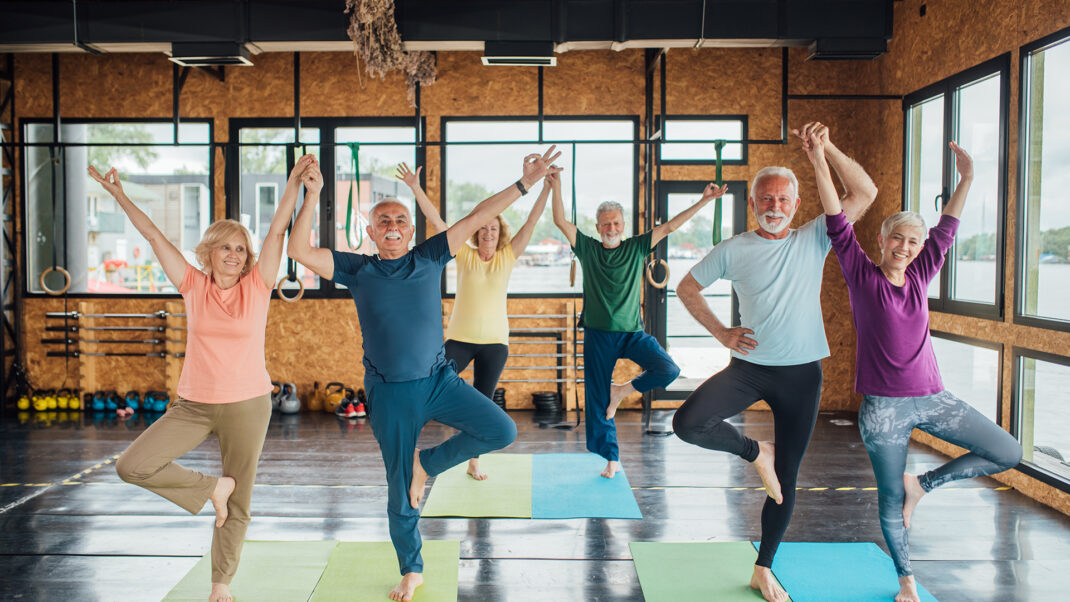Turn Negatives Into Positives
Embrace your role as a fitness leader, and cue moves for success and safety.

I was a new group fitness instructor taking someone else’s muscle-toning class. “You’re not going low enough,” the instructor yelled at me from across the crowded room. As flames of embarrassment burned my cheeks, I dropped lower into the Romanian dead lift even though I had just come from teaching my seventh cycling class of the week and my body was spent. But this was what the class required, I rationalized, and I was fit—I should be able to keep up.
Unfortunately, I couldn’t keep up, and as a result, I gave myself a nagging lower-back injury.
Though the group fitness setting is unique in its ability to motivate, educate and inspire, it also has the potential to be destructive. “You have a group of people with many different issues, and you have no idea what those issues might be,” says Dixie Stanforth, PhD, senior lecturer at The University of Texas at Austin. “You need to create a workout that’s both effective and safe for large groups of people, which is difficult.”
It’s easy to forgo sound programming principles in favor of energy, intensity and calorie-burn; however, as a group fitness instructor, you have the job of providing a challenging and enjoyable workout while keeping participants’ health and safety in mind. This article explores the potential for negative outcomes in the group fitness setting and outlines strategies to safeguard against them.
Programming Intensity
High-intensity interval training (HIIT) is still hot in group fitness—and for good reason. HIIT can improve aerobic and anaerobic fitness in less time than traditional steady-state training (Tabata et al. 1996). With the irrefutable benefits of HIIT in mind, it’s safe to presume that if some is good, more is better. However, HIIT is extremely demanding and so warrants close consideration.
In the HIIT format, high-intensity exercise intervals alternate with varying amounts of recovery. The exertion level is 80%–95% of estimated heart rate maximum (HRM) during high-intensity intervals and 40%–50% of HRM during recovery (Kravitz 2014). As such, “high intensity” varies from person to person. “High intensity is relative,” Stanforth says. “For someone with a really low aerobic base, there isn’t a big difference between base training and peak performance.” Consequently, exercises and intensity must be scalable (see the sidebar “Measuring Intensity”).
HIIT is a great tool for increasing aerobic capacity in minimal time, but it’s not something that should be used in every class. “HIIT can be overused in group fitness settings if not properly programmed,” says Matthew Cain, MS, assistant professor at San Diego Miramar College. “Individuals require longer recovery periods with HIIT, and it’s not intended to be performed every day.”
Too much HIIT can lead to overtraining, injury or diminished performance, but you can program high-intensity intervals into your classes responsibly. Here are some tips:
- Provide adequate recovery time between bouts.
- To target the anaerobic energy system, do shorter intervals with very high intensity and longer rest periods. For example, the “spring training” method requires 30 seconds of near-maximal work with 4 minutes of recovery, for a work-to-rest ratio of 1:8.
- When focusing on the aerobic energy system, hold intervals longer and choose a lower work-to-rest ratio. The intensity will not be quite as high as for the anaerobic system. For example, perform 2 minutes of high intensity followed by 2 minutes of active recovery, for a 1:1 work-to-rest ratio (Kravitz 2014).
Educate members on the principles of HIIT and the rest and recovery needed to progress optimally. Explain that “high intensity” is relative to the individual, and encourage every participant to take control of his or her own regimen. “The artistry of leading a group is in providing a variety of movement experiences . . . and letting participants know that it’s okay if one person does something that looks totally different from what someone else is doing,” says Stanforth.
Create a “Culture of Mastery”
Leading a group requires more bandwidth than working with a client one-on-one. Exercises that are challenging to cue or that require a great deal of mobility pose a greater risk in group classes.
The group fitness setting is an ideal venue for people to learn how to exercise safely and successfully, with and without equipment. “Part of the class structure should be for people to learn how their bodies move and how to safely and properly use equipment,” says Brett Klika, CEO and co-founder of SPIDERfit Kids® in San Diego. “All too often, instructors are merely cheerleaders, with very little instruction or expectation. Mastery, not just noise, should be celebrated.”
Timing is tight in class, and it’s tempting to sacrifice education to maximize caloric expenditure. However, this approach limits your opportunity to help participants move properly and learn skills they can carry over to the rest of their lives. “Instructors should spend the first 5–10 minutes of a session teaching common movement patterns that will be used that day,” says Cain. Once you’ve gone over basic form cues and modifications, you can quickly refer back to your original cuing as needed.”
The variety of equipment available for group fitness is immense, and so is the potential for equipment-related injury. “When it comes to the dangers involved with equipment, creating a culture of mastery is important,” says Klika. “If I taught a karate class, I wouldn’t be handing out swords and ninja stars the first day.” Klika highlights the power of using the body for resistance. “I’ve become a huge fan of body-weight exercises,” he says. “[I recommend using] the floor, walls and partner [training] to provide a challenge and to help teach a movement correctly.”
Movement Modification
Knowing the injuries and limitations of each class participant is impossible, so it’s crucial to be able to modify moves. “Fitness instructors need to be aware of the progressions and regressions associated with each exercise so they can quickly modify for each participant as needed,” says Cain. Many participants have injuries that make certain movements unsafe. In particular, overhead movements, lunging, squatting and hip-hinging exercises can be difficult for people with shoulder, knee or hip limitations. Be prepared with modifications that will provide a challenge and still keep participants safe (see the sidebar “Risky Moves”).
One common mistake people make is to progress too quickly by adding load before a movement pattern is properly set. “Decreasing the load allows participants to focus on improving the required motor control,” says Arash Maghsoodi, DPT, co-founder of The Prehab Guys in Los Angeles. “Only after proper mechanics are achieved should you begin to load those movements.”
In a fitness culture that screams for bigger, better, faster and stronger, helping people understand the need for recovery, correct form and proper progression is imperative. “If the goal is to do 20 pushups, and it doesn’t matter how I do them, that is a communication problem,” Stanforth says. “We need to focus on high-quality movement and communicate that this matters [for] safety and effectiveness.”
By using sound programming principles, encouraging self-selected exercise intensities and creating a culture of mastery, you help people improve their exercise habits both inside and outside of class. This strategy enhances your participants’ well-being and empowers them to remain active for years to come.
One way to support participants in their fitness goals is to introduce them to tools that help them monitor how hard they’re working. The Borg Scale of Perceived Exertion measures exercise intensity from 6–20 (CDC 2015). High-intensity intervals should fall within the 15–19 range, with recovery intervals falling in the 9–12 range. Introduce this scale to participants so that they can self-monitor intensity and know they’re working at an appropriate level.
The likelihood of injury outweighs the benefits when some exercises are performed in a group setting. The following moves can be hazardous, owing to common mobility and stability limitations.
Romanian dead lift. This move requires a hip hinge, which many people are unfamiliar with. It can be difficult to learn, and when it’s performed improperly, injury risk is high. “People often exhibit excessive lumbar spinal flexion in the Romanian dead lift, putting stress on lower-back structures,” says Arash Maghsoodi, DPT, co-founder of The Prehab Guys in Los Angeles.
Quick fix: Help class members find a neutral lumber-spine position and cue core engagement. Have participants maintain this neutral spine/engaged core while moving through the hip-hinge pattern unloaded. Place a dowel behind the back—held against the sacrum, thoracic spine and back of the head—to teach proper form. If you want to achieve similar results with less risk, lead the class in supine glute bridges.
Overhead press. This exercise poses a risk to clients with poor shoulder or midback mobility and compromised core activation. “With the overhead press, people often hyperextend at the lower back to compensate for mobility deficits elsewhere, increasing risk for injury,” Magshoodi says. “Further, clients with poor shoulder range of motion can exacerbate shoulder injuries when moving weights overhead.”
Quick fix: When teaching the overhead press, cue core engagement to protect the lower back. You can also teach the move from a half-kneeling stance with the glutes engaged. This limits the lower back’s ability to hyperextend, keeping clients in a safer range of motion. For those with limited range of motion in the shoulder, try a chest press or lateral raise to target the upper-body musculature without bringing the arms overhead.
Excessive spinal flexion. To improve core muscle function, core training should be balanced on all sides, not just the front and the back. The predominant form of core training in many group classes involves only the front abdominal wall via flexion (i.e., crunches), which can lead to muscular imbalances and lower-back pain.
Quick fix: To find balance, include exercises that target the posterior and lateral sides of the core, such as planks, side planks, bird dog and dead bug, as well as rotational movements like Russian twists.






